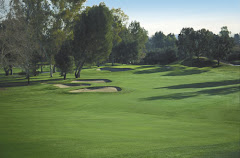Well the summer heat has arrived. We are in the middle of a long extended heat wave. The last seven days have brought us temperatures near 100 everyday and the forecast is for this heat wave to continue well into next week. While we have kicked our greens maintenance program into overdrive with syringing, leaching cycles every seven days and preventative fungicide applications, our last step in preserving the health of our greens through the heat of the summer is raising the mowing height. I raise the mowing height as a last resort because in addition to slower green speeds and I feel that smoothness is negatively affected on our Poa annua putting surfaces. In order to minimize the affect of the higher high of cut we will be rolling greens two to three times a week.
To help explain the benefit and necessity to a raising cutting height I want to share something the Dr. Larry Stowell from Pace Turf has published.
" What do golf course putting greens and thoroughbred race horses have in common? More than you might think. Both are high performance products of scientific innovations in breeding and management that have resulted in faster horses — and faster greens — than ever before in history. As a result, both require specialized and intensive care to achieve their high performance levels. Like horses, turf must be supplied with sufficient nutrition, water and care. If they are lacking in any of these, they become weak, more susceptible to disease, and incapable of high performance. Without attention, they die of starvation. The importance of being green: Unlike animals, plants don’t have to obtain their food from outside sources. Instead, through the remarkable process of photosynthesis, they can make their own food inside the green tissues of their leaves and stems. All they need is sunlight, air, water, and enough green tissue, and Presto! They can manufacture enough starch and energy to fuel their growth and reproduction. But many factors can interfere with photosynthesis. On golf course greens, mowing heights that are too low are one of the most important, and one of the most common reasons that greens fail during the summer. There comes a point when the turf plants simply don’t have enough food to support the growth of roots or the production of new leaves. If the plants are mowed too low for too long, their food becomes limited, they become weak, and they eventually succumb either to
disease or starvation.
Higher mowing = recoup time for turf: While greens (like race horses) can survive extreme conditions such as low mowing for short periods of time, their long-term survival depends on time for recuperation, when higher mowing heights allow for production of new leaves, roots and other tissues.
Bottom line: Fast greens can become dead greens quickly, especially during the summer when turf is already stressed by heat. The low mowing heights that produce faster greens can remove so much leaf tissue that the plant is unable to produce the energy it needs to survive. Research has shown that even a slight increase (1/32”) in mowing height can result in dramatic improvements in turf quality, disease resistance, recovery from stress and root growth. It is therefore frequently necessary to raise mowing heights during the summer or other periods of stress. Green speeds may decrease as a result, but when you consider the alternative — that is, dead turf — it is a small price to pay."
Friday, July 17, 2009
Subscribe to:
Post Comments (Atom)








No comments:
Post a Comment